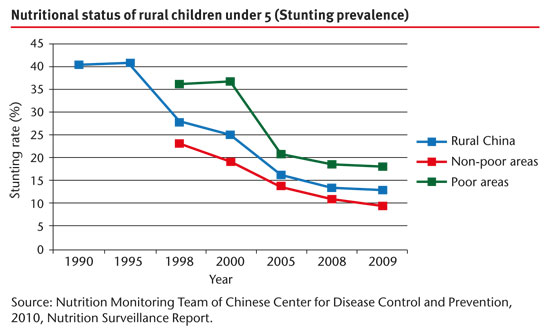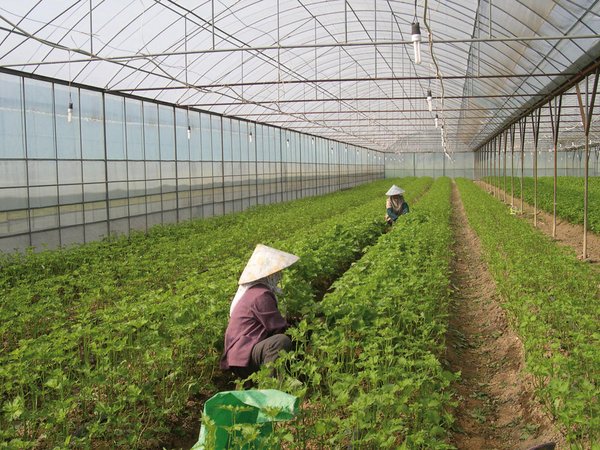 Download this article in magazine layout
Download this article in magazine layout
- Share this article
- Subscribe to our newsletter
Agricultural policy reform and food security in China
In 1976, when China was still under the planned economy, the nationwide average annual per capita income in the People’s Communes (the agricultural collectives) amounted to 60.2 Yuan, which was lower than that of 1956 at constant prices. At that time, more than one third of farmers’ households were in debt, and about 100 million farming people suffered from a shortage of food. By 1978, China was no longer self-sufficient in grain and had to rely on imports to supply 40 per cent of the urban population.
Farmers created a responsibility system with an output contract for the work groups in 1978 and developed it into a household contract system in 1981. The initiative of the farmers was given a positive response by top-level leadership, and eventually, it led to the abolition of the People’s Communes. The following principle measures in the reform programme were implemented during the 1980s:
- A family farm system replaced the collective system. Every peasant household now ran a small farm with the right of usufruct for an average 0.5 hectares of farmland.
- Price and marketing policies changed by means of lifting the state monopoly on purchasing and marketing farm products, opening the free market, introducing the state contract purchase system and raising prices.
- Structural policies were devised to stimulate agricultural diversification.
- Rural non-agricultural economic development policies were designed in order to shift surplus labour away from agriculture.
The above-listed measures were issued through Document No.1 of the Central Committee of the Chinese Communist Party at the beginning of each year during 1982–1986, which indicates the first priority in the decision-making fields of top-level leadership. Document No.1 first plays a role in getting the local governments to pay special attention to food production and rural development. Second, it publicises the measures to target the short-term goals of the policies for the year that the document refers to. Third, it reasserts the mid- and long-term strategies and policies for food security and rural development. During 2004–2013, Document No.1 mainly emphasised the issues below:
- To establish a minimum price guarantee system for rice and wheat growers in response to market signals with the purpose of protecting farmers from price volatilities. At the same time, farmers are now in a position to sell their products to any other buyers when the market prices are higher than the guaranteed prices offered by the public purchase agencies. The minimum purchasing prices for public procurement have been raised steadily. For example, the price was set at 1.64 Yuan/kg for first-grade paddy rice in 2008, while it has been 3 Yuan/kg in 2013, and first-grade wheat prices are 5 per cent lower than the paddy rice prices during the same period.
- To subsidise grain growers with direct payment links to sown areas and purchase of high quality seeds (and animal breeds), machinery and tools, and agricultural inputs, such as diesel and chemical fertilisers.
- To increase public investment in agricultural research and infrastructure improvement. For instance, in 2011, central government spent 130.99 billion Yuan, the equivalent of 21.1 billion US dollars (USD), on the construction of rural roads, power and irrigation facilities.
- To expand key demonstration zones for agricultural technology extension. In addition to the provision of extension services, mechanisation of the small farms is promoted through the production of small tractors and machines. The better-off farmers are also motivated to specialise in machine service and enter the agricultural service market. The modernisation of small-sized agriculture has brought about a significant increase in grain yield, from 3 tons per hectare in 1984 to 4.88 tons in 2008.
- More investment is allocated to capacity building for disaster prevention and mitigation as well as to land consolidation and amelioration. Fiscal spending of central government on these items amounted to 104.2 billion Yuan, equivalent to 16.8 billion USD, in 2011.
Public support has dramatically strengthened food availability with increasing yields. The total yield of grain production exceeded 400 million tons in 1984, and it reached a level of over 500 million tons in 2010. The yield of edible oil went beyond 16 million tons in 1990 and doubled in 2010. The output of meat production was counted for 29 million tons in 1990, and it had increased by 189 per cent by 2012.
Effects of the reform processes on poverty reduction
Agricultural growth during 1978–1985 as well as an accelerated process of industrialisation and urbanisation since the 1990s enabled a majority of rural households to attain food security and get out of poverty. The Table below shows that an average household’s grain output commercialisation rate increases as the area of its farmland is gradually reduced. The share of non-agricultural labour has risen, while the proportion of the farming income has declined in the total income of the household. First of all, such a tendency reflects the fact that part of agricultural land is turned to non-agricultural use. Second, agricultural productivity is enhanced. Third, around 260 million rural labourers have migrated into the urban areas and provide considerable remittance to their families in their home towns or villages each year.

Together with the rural reform process the central government launched a poverty reduction programme in a few provinces in western China in 1982 and initiated a nationwide antipoverty strategy in 1986, aimed at providing food and clothing for the poor through promoting development in poor areas. By 1994, the goal of food security was virtually achieved. Subsequent antipoverty schemes have chiefly aimed at eliminating income poverty, and in the main antipoverty measures so far, socioeconomic and human resource development projects have been run. According to the poverty line set by the World Bank (USD 1.25/day per capita consumption or income), China’s urban poverty incidence dropped from 44.5 per cent in 1981 to 0.9 per cent in 2008, whereas the incidence of rural poverty dropped from 94.2 per cent to 22.3 per cent during the same period. In 1978, when rural reform commenced, rural poverty in China was identified among 250 million people. It was measured with a poverty line defined by an annual food grain accessibility of 200 kilograms per capita.
Addressing extreme poverty and child malnutrition for 2011–2020
For the period of 2011–2020 the Chinese government initiated a new programme for rural poverty reduction, and at the end of 2011, it lifted the poverty line to 2,300 Yuan per capita annual net income equivalent to 1.8 USD per day at 2005 purchasing power parity. Measured with the new poverty threshold, the size of rural poverty is estimated at 128 million people, or 13.4 per cent of the total rural population. Among the rural poor, there are 17 million children under the age of 6 years, accounting for 20 per cent of the total rural children at the same age.

In the past three decades, child malnutrition has almost been eliminated in cities. The nutrition monitoring team found out that the low-weight and stunting indices of the urban children under the age of 5 years had dropped from 5.3 per cent and 11.4 per cent to 1.4 per cent and 3.1 per cent during 1990–2005. Compared to children living in cities and non-poor rural areas, malnutrition of the children in the same age group but living in the poor rural areas remains a challenge. From 1998 to 2009, the low-weight rate of this age group declined from 14.5 per cent to 6.6 per cent, and stunting prevalence was reduced from 36.4 per cent to 18.3 per cent. However, in 2010, the stunting rate of the children aged from 12–24 months was still observed at a peak of 22.8 per cent.
The government has taken comprehensive and multi-dimensional measures to tackle the remaining food supply gap, extreme poverty and child malnutrition:
- Maintaining food supply and demand balance through self-sufficiency in staple grains with imports of soybean and edible oil. In fact, China has already been importing about 40 million tons of soybean and around 8 million tons of edible vegetable oil each year.
- Extending the social protection system from the urban to the rural. Currently, over 95 per cent of rural people are part of the medical co-operative system. Since the end of 2009, an experimental pension system has been in progress, and now, farmers aged over 60 years are eligible to receive a monthly non-contributory benefit of 55 Yuan from central government finance. Moreover, a rural minimum living standard guarantee system has been set up to target the extreme poor, and it is financed by both the local and central governments. In 2012, 28 million rural households with more than 53 million people were assisted with a monthly average cash transfer of 104 Yuan per capita. The share of the transfer from central government accounted for 65.1 per cent and 60.1 per cent for the urban and rural schemes.
- During the period of the 12th 5-year national socioeconomic development plan (2011–2015) and over the next decade, the Chinese government will continue to prioritise the elimination of absolute poverty in its antipoverty strategies. The extremely poor areas that are adjacent to each other (especially areas inhabited by ethnic minorities, border areas, and ecologically delicate areas) will be the key regions for carrying out the antipoverty programme, centring on increasing poverty relief funds and gradually raising the poverty line.
- Starting from spring semester in 2012, central government has undertaken a school feeding programme in 669 hardcore poor counties that covers 26 million rural children.
- At the same time, an experimental programme of nutrition intervention is being implemented in 100 counties in ten provinces, with supplementary food for the rural children aged 6-24 months.
Conclusion
China is in continuous fast transition to industrialisation and urbanisation, and is striving to maintain sufficient food supply. New measures are increasing the farmers’ own productivity through developing the small farms, decreasing market regulations, and expanding international trade in food. Poverty reduction and social security programmes together with better education are parts of the efforts to strengthen agriculture and food security.
* Zhu Ling is a Professor at the Chinese Academy of Social Sciences and this year’s winner of the Justus von Liebig Award for World Nutrition. The Award is conferred annually by the fiat panis Foundation in recognition of outstanding achievements in combating hunger and rural poverty; also see: www.rural21.com
Zhu Ling*
Institute of Economics
Chinese Academy of Social Science (CASS)
Beijing, China
zhuling@cass.org.cn





Add a comment
Be the First to Comment